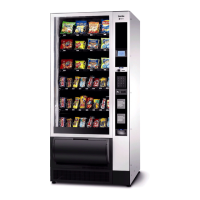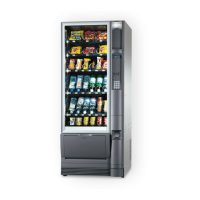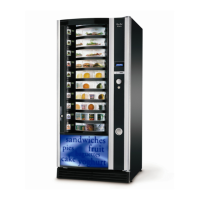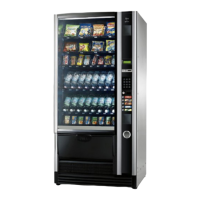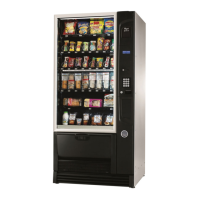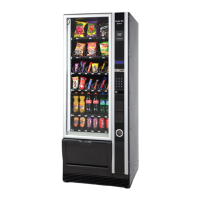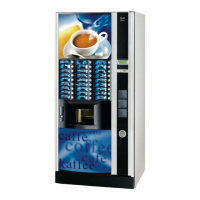Do you have a question about the Necta Canto Plus Espresso and is the answer not in the manual?
| Brand | Necta |
|---|---|
| Model | Canto Plus Espresso |
| Category | Vending machines |
| Language | English |
Provides information about the machine's compliance with European directives and standards.
Instructions for installation personnel regarding safe and correct setup.
Guidance for safe operation by users, including children and individuals with disabilities.
Tips for protecting the environment during machine use and disposal.
Explains various symbols used within the machine to indicate hazards.
Guidance on troubleshooting common issues and when to contact the manufacturer.
Procedures for safely moving and storing the vending machine to prevent damage.
How to locate and understand the machine's identification plate and serial number.
Guidelines for installing the vending machine in a suitable indoor environment.
Details on the cup dispenser's size and capacity.
Information on electrical pre-arrangement for various payment systems.
Options to reduce electricity consumption during non-use periods.
Overview of the machine's external controls and user interface elements.
Lists the safety mechanisms integrated into the machine for user protection.
Details the capacity of various product containers and indicative quantities.
Information on the machine's power usage under different conditions.
Overview of optional accessories that can enhance machine performance.
Instructions for customizing and using the machine's combination lock.
Explains the function of the door switch for safety during operation.
Procedures for maintaining machine hygiene and preventing bacteria buildup.
Guidelines for using hot drink dispensers with open containers.
Specifies the maximum sound pressure level of the machine.
Step-by-step instructions for loading cups into the dispenser.
Guidance on filling containers with sugar and instant product powders.
Instructions for filling the coffee bean container.
Procedures for correctly loading stirrers into the dispenser.
Procedures for cleaning and disassembling the espresso unit components.
Instructions for cleaning the sugar dispenser mechanism.
Instructions for disassembling and cleaning the dispensing compartment.
Procedures for cleaning mixer channels and container support surfaces.
Actions to take when the machine is out of service for an extended period.
Explanation of the door switch's safety function and operation.
Steps for safely unpacking and checking the machine for damage.
Instructions for applying selection labels and product container labels.
Guidelines for connecting the machine to the potable water supply.
How to restore operation if the antiflood device is activated.
Information on mounting and using a decalcifier for hard water.
Requirements and safety precautions for connecting the machine to the power supply.
Guidance on installing and configuring various payment systems.
Information on configuring machines for bank installation and master/slave setups.
Step-by-step guide for filling the machine's water circuit during initial setup.
Procedures for initial sanitization of mixers and food circuits.
Details on the compartment cover's function and its impact on drink quality.
Instructions for mounting the cup guiding device for proper cup placement.
Explanation of the cup sensor's function, LEDs, and maintenance.
How the stirrer sugar dispenser operates and is loaded.
How the espresso unit performs a complete rotation on power-on for initial positioning.
Parameters to check for optimal product results, like coffee dose and temperature.
Information on the coffee unit's operational volume for coffee doses.
Instructions on adjusting the coffee dose using the regulation lever.
How to adjust the coffee grinder's fineness setting using the knob.
Explanation of the automatic grinding system and its function.
How the machine uses a reference selection to monitor automatic grinding parameters.
How to stop the automatic grinding wheel regulation.
Procedure to check for grinding wheel wear and reset related timers.
How to manually adjust grinding wheel distance via software.
Maximum coffee dose the brewing unit can handle and manual adjustment.
How to set water quantity based on selection and brewing time.
How grinding degree affects brewing time and automatic adjustment.
Details on instant mixers, pumps, and nozzle types for water dispensing.
Adjusting water doses and checking mixer flow rates for custom drinks.
Setting ingredient motor flow rates for accurate powder dispensing.
How to set boiler temperatures for espresso and instant units via software.
Controlling coffee dose, water dose, and temperature for instant products.
General notes on machine programming and available functions.
Describes the machine's state when powered on with all checks performed.
Accessing menus for statistical findings and simple operational checks.
Accessing menus for machine setup, performance programming, and advanced functions.
How the operator interacts with the system using display and keys.
Information on the graphical display's role in showing messages and menu functions.
Explanation of keyboard functions for selection and menu navigation.
Messages displayed during machine power-on, including software version and potential errors.
Message sequence shown to the user during normal operation for drink selection.
Storing and managing machine operation data in total and relative counters.
Instructions for printing stored statistics data via an RS232 serial printer.
Sequencing and displaying stored statistical data from the machine.
Setting up to four different prices per selection based on time bands or payment systems.
Functionality for loading or emptying coin change tubes, active with specific payment systems.
Reading the current boiler temperatures for espresso and instant units.
Performing partial or complete test dispensing of selections without payment.
Configuring signals for low product levels or machine faults sent via GSM modem.
Waiting for connection to acquire EVADTS data.
Accessing menus for machine setup, performance programming, and advanced functions.
Enabling and managing protocols for various payment systems like Validator, Executive, MDB.
Configuring parameters for the validator, including immediate change and decimal point settings.
Options for the Executive payment system, including standard and UKEY versions.
Functions for the BDV protocol, such as type of sale and credit management.
Details on MDB protocol audit data related to coin mechanism and sales.
Defining combinations of empty tubes for the coin mechanism's "exact amount" mode.
Enabling or disabling buttons on the coin mechanism for discharging coins.
Informing the coin mechanism about installed peripheral units.
Setting a warning for low coin levels in change tubes.
Managing free sale function and setting selection prices to zero.
Defines coin return, banknote acceptance, and below-level acceptance rules.
Manages cashless privacy, overpay, cash-sale evidence, and cashless credit limits.
Sets exact change algorithms, user price lists, and parallel machine functions.
Setting prices for each selection individually or globally.
Defining time ranges for different pricing strategies.
Accessing sub-menus to manage parameters for specific selections.
Modifying doses and parameters for water and powder ingredients in drinks.
Setting the duration, speed, and time for the mixing cycle.
Setting water quantity, event start order, delay, and flow rate.
Setting brewing time and powder quantity in grams for ingredients.
Defining wait times and enabling/disabling selection keys.
Enabling or disabling specific accessories like sugar, stirrer, and cup.
Performing test dispenses for complete selections, water only, powder only, etc.
Assigning a unique code to each selection for statistics processing.
Regulating powder dose for multiple selections simultaneously.
Adjusting pump speed and flow rate for accurate dispensing.
Setting ingredient motor flow rates for accurate powder dispensing.
Modifying key order, using double keys, and managing no-sugar/decaff settings.
Setting the current date and time for time band and statistics management.
Setting operating temperatures for available boilers.
Managing basic machine data, including initialization and custom database saving/restoring.
Configuring country-specific doses and button-selection layouts.
Defining the water supply source (network or internal tanks).
Selecting display language, secondary language, and promotional messages.
Setting screen saver time and adjusting LCD display contrast.
Requesting a password to access advanced menu functions.
Enabling/disabling grinding for the next selection to reduce dispensing time.
Heating the water circuit and espresso unit before brewing.
Setting unit position, fresh brew parameters, and pre-brewing time.
Regulating piston speed and pressure on the dose in the brewing chamber.
Choosing from available profiles for coffee and tea based selections.
Enabling the button for washing mixers and setting automatic wash times.
Setting the time for the daily automatic washing cycle of the espresso unit.
Dispensing hot/cold water before certain selections based on recent activity.
Defining the water supply source (network or internal tanks).
Using a photocell to detect objects in the dispensing compartment for cup sensing.
Obtaining cup-free selections and dispensing stirrers from columns.
Adjusting cup shift arm and cup turret timing for proper cup drop.
Selecting energy saving modes to reduce electricity consumption.
Configuring master/slave hierarchies and numbering for connected vending machines.
Scrolling information relative to a connected slave machine.
Setting serial number, operator code, location code, and machine code.
Setting continuous operation for the suction fan wheel of instant products.
Dispensing selections without payment for testing purposes.
Accessing functions like operating the brewing unit, releasing coffee doses, or dispensing stirrers.
Enabling automatic regulation and setting parameters for grinding wheels.
Resetting stored times after replacing grinding wheels.
Performing a test on grinding wheels without coffee after replacement.
Performing semiautomatic checks on the machine's main components.
Storing and resetting dispensing cycles performed since the last reset.
Identifying the machine for data transfer using EVA-DTS protocol codes.
Selecting the communication protocol for data acquisition devices.
Selecting interface, setting transmission speed for data transfer.
Displaying stored statistical data like counters by selection or band.
Resetting statistics globally or selectively for various data types.
Displaying relative statistical data, such as counters by selection or band.
Resetting statistics selectively for selections, discounts, failures, or coin mechanism data.
Providing information on BDV protocol audit data in real currency.
Details on MDB protocol audit data related to coin mechanism and sales.
Connecting a printer to print stored statistics and machine data.
Configuring PIN code, threshold setup, counter reset, and bank number.
Selecting a setup file from a list on the display to load onto the machine.
Saving the current machine configuration to an Up key.
Deleting one or more setup files from the Up key.
Saving and deleting statistics files to and from the Up key.
Displaying current failures and messages indicating out-of-order status.
Resetting current failures and viewing the failure history file.
Details on failures like no water, full waste container, air-break, and no cups.
Failures related to cup shift arm, volumetric counter, instant boiler, and machine board.
Failures related to coin mechanism communication and coffee unit mechanical lock.
Failures for empty coffee, grinder lock, RAM data, and espresso boiler temperature.
Failures related to cup sensor, FB piston/brush positioning errors.
Faults for door motor, doser, whipper, and pump motors due to input range issues.
Failures related to short circuits in Mosfet devices and DC motors.
Motor faults and water failure detection if solenoid valve operates excessively.
Resetting current failures and viewing the failure history file.
Procedures for servicing the brewing unit every 10,000 cycles or 6 months.
Steps to disassemble or replace the upper and lower filters and gaskets.
Cleaning and disinfecting the entire circuit and food-contact parts annually.
Regular removal of powder residue and sanitization of parts in contact with mixer drinks.
Information on nozzle/pump combinations, flow rates, and software nozzle type setting.
Instructions for disassembling the cup dispenser columns and cup release ring.
Steps for cleaning product containers, outlet ports, and augers.
Procedures for descaling boilers at regular intervals based on water hardness and usage.
Steps to disassemble pumps secured by a bayonet connection.
Actions to take when boiler thermostats activate due to failures.
Explains how anti-boil and safety thermostats function to protect the boiler.
Explains the function of the contact safety thermostat for the espresso boiler.
Instructions for replacing grinding wheels and resetting related settings.
Performing a test on grinding wheels without coffee after replacement.
Checking board configuration and downloading corresponding software for performance changes.
Rewriting machine management software without replacing EPROMs using a PC or handheld computer.
Explains the functions of the CPU board and its LEDs for operation status.
Explains the function of the actuation board in activating users and controlling the instant boiler relay.
Board that controls the espresso boiler heating element.
Board that supplies lighting LEDs and maintains constant brightness.
How to navigate through menus using the machine's keys.
Using up/down keys to navigate menus and change values.
Using Enter key to confirm/move, and Exit key to go back or switch menus.
How keys function when entering alphanumeric characters for settings.
